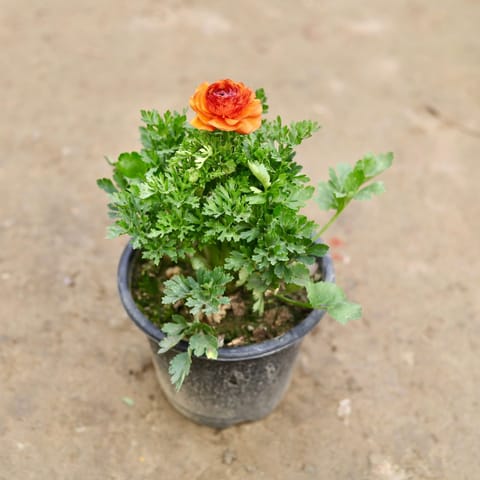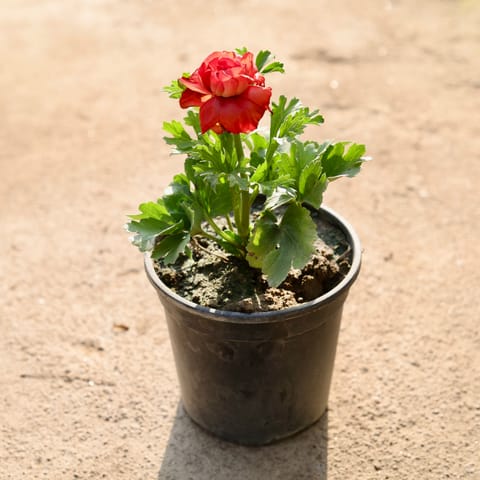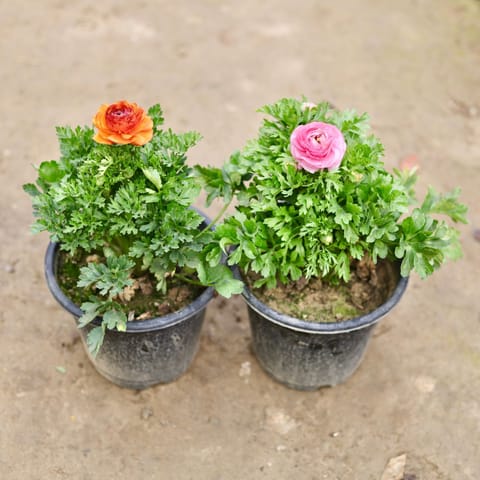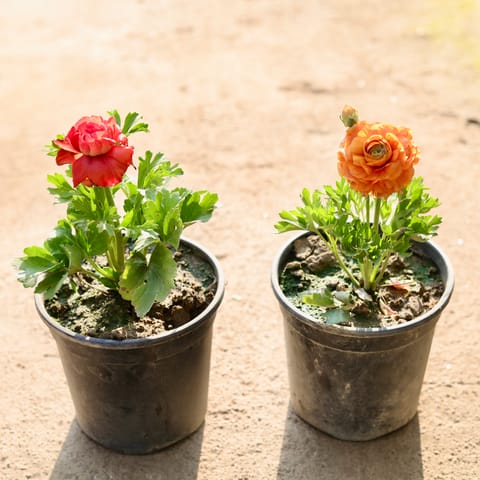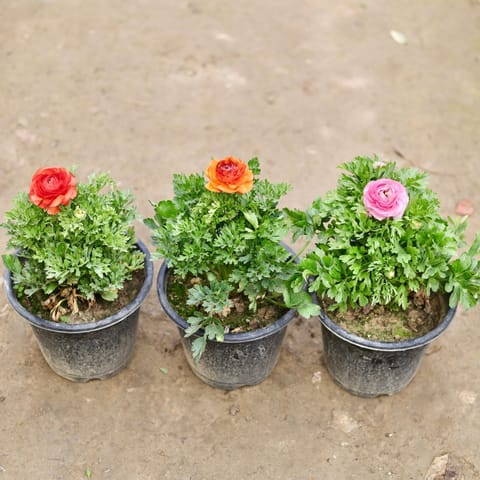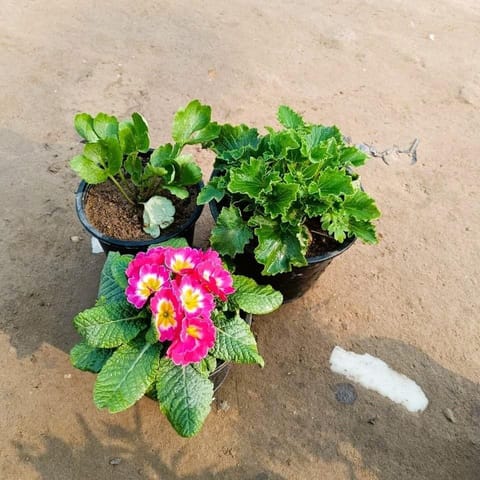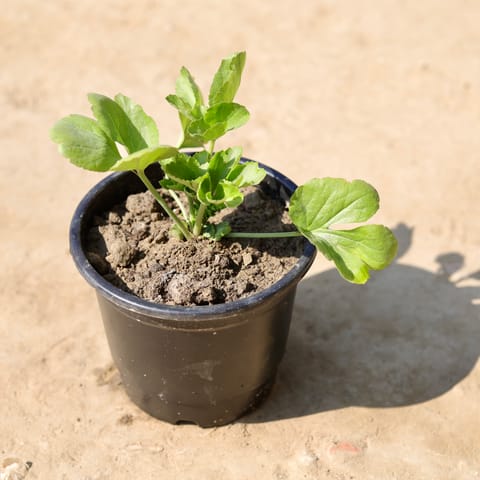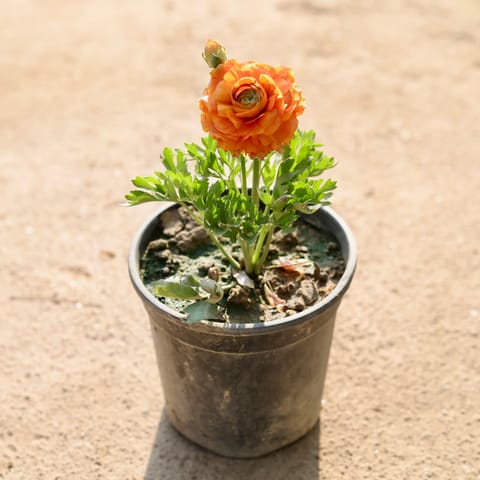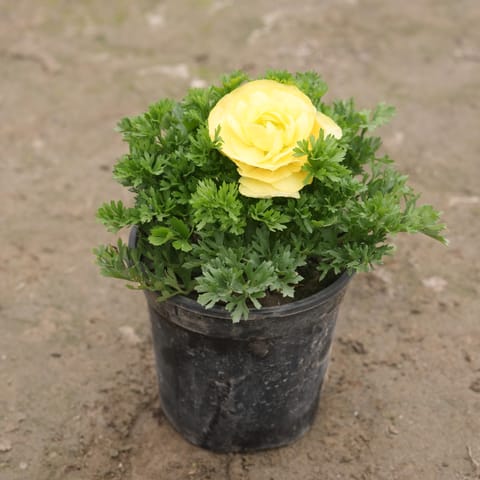Shop

Downalod our app
Search our catalog
Recent Search

Please provide your delivery pincode to see products available in your area
Recent Search
Are you sure you want to logout?
You will be logged out of your account
Your current session will end and you'll need to sign in again to access your account.
Ranunculus Plant
Buy Ranunculus Flowering Plants Online at Urvann
The Ranunculus fl...
Buy Ranunculus Flowering Plants Online at Urvann
The Ranunculus flowering plant is a gorgeous plant with stunning bowl-shaped blooms. Gardeners and florists love it.
The blooms are too perfect to be true, as they resemble a rose flower with many layers of thin tissue-like petals ranging from shades of cream and pale yellow to pink, orange, and red. Ranunculus is also known as the Persian Buttercup plant and is scientifically known as ‘Ranunculus asiaticus’. It belongs to the genus Ranunculus, which has almost 600 species of plants belonging to various regions of the world. These are cool-season plants warming up the groggy mornings of winter.
Why Should I Grow Ranunculus Flowering Plants?
The Ranunculus flower plants have many benefits for your home garden. Here are a few of them:
Gorgeous Blooms
The rose-like ruffled blooms of the Ranunculus plant in bright, cheerful colours give your garden a delicious vibe. The flower heads nod in the breeze, spreading their charm all around. The plant's flowers have a long blooming period, letting your garden stay colourful for a long time.
Low-Maintenance
Ranunculus plants are easy to care for and thrive on minimum care requirements once established. You can also plant these from Ranunculus bulbs, readily available online in the growing season from the beginning of March until the monsoons arrive. Once established, you can get blooms from the plant during the flowering season.
Attracts Pollinators
Every gardener loves to see beautiful butterflies hovering over their precious flowering plants in search of nectar. One way to do this is to plant the Ranunculus and watch bees and butterflies haggle for nectar from their favourite flowers.
Citrusy Scent
The Ranunculus flowering plants have a mild citrusy scent that can keep certain pests, including mosquitos, away from your home garden.
Care Tips for Ranunculus Flowering Plants
Here are some essential care tips to keep your Ranunculus Flowering Plant Plants healthy and thriving
When should I water Ranunculus plants?
Water the plant when the top soil (1-2 inches) feels dry. Ensure the soil is well-draining so that excess water can flow and the plant is not overwatered. Excess standing water can suffocate the roots, damaging the plant. Also, water thoroughly in the summers and reduce watering in the winter and rainy seasons.
What amount of sunlight do Ranunculus plants need?
The Ranunculus Flowering Plant loves the sun and must receive it for at least 5-6 hours daily to thrive. However, when there is a lot of scorching sunlight, protect the flowers by covering them with a thin sheet of cloth or shift them to a partially shaded location.
What type of soil do Ranunculus plants prefer?
Ranunculus Flowering plants prefer well-draining soil, which allows excess water to flow out and prevents the root system from being blocked, making them unable to breathe. Ideally, the soil composition for flowering plants should be, Garden Soil (35%) + cocopeat (30%) + Vermicompost (30%) + Neem Khali (5%)
When to fertilise Ranunculus plants?
The Ranunculus Flowering Plant is not very demanding. It can be fed vermicompost or cow dung compost every 45 days to maintain its nutrition balance. It can also be easily propagated from the bulbs found near the roots.
How To Decorate Your Home Garden with Ranunculus Flowers
Make a Garden Bed with Ranunculus Plants
Ranunculus are showy flowering plants that make garden beds or hedges. The plant's natural growth habit is tall when grown directly on the earth, creating beautiful garden scapes.
Make Hanging Planters with Ranunculus Plants
The Ranunculus grows in a controlled environment when grown in containers. Hence, they can also be planted in hanging planters, perfect for urban homes with limited balconies or terrace space.
Focal Points with Ranunculus Plants
The Ranunculus can be planted to serve as focal points of your home garden. Create a symmetrical arrangement, placing your plants in the centre to catch eyeballs immediately.
Why Choose Urvann to Buy Ranunculus Flowering Plants Online?
When selecting Urvann, you are opting for convenience. Purchase the Ranunculus Flowering Plant at cost-effective prices without the concern of transportation hassles. We provide free next-day delivery, ensuring optimal conditions upon arrival at your doorstep. Furthermore, our dedicated customer support team is readily available to address any inquiries, using their extensive knowledge and expertise to guarantee your contentment. Should you have any plant parent concerns, we are just a phone call away!
FAQ About Ranunculus Flowering Plants
1. When should I plant Ranunculus flowers in India?
The Ranunculus flowering plants can be planted at the end of the monsoon season in India. This will give the plant a few months before the winter chill starts to set in.
2. How do I deadhead my Ranunculus flowers?
Remove spent Ranunculus flowers by taking a pruning scissor and cutting just below the first set of leaves.
3. Can Ranunculus flowers be grown in the shade?
The Ranunculus flowering plants need lots of sunshine to start blooming. Hence, they cannot reach their full potential in the shade.
4. How long do Ranunculus flowers bloom?
Ideally, a blossomed flower will stay on the stem for a week before starting to decline.
5. How do I know if my Ranunculus flowers are healthy?
If your ranunculus flowers have at least 6-7 layers of petals and are firmly attached to the stem, it is a healthy plant. It is a healthy plant if the leaves look green and bright without discolouration or wilting.
6. How can I collect bulbs of the Ranunculus flower plant?
When repotting or replanting your Ranunculus, check the soil near the roots for round bulbs. These bulbs are essentially seeds for a new Ranunculus to grow. Collect these bulbs and sow them in a new planter.
